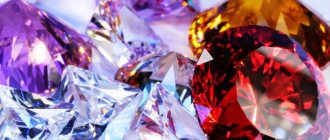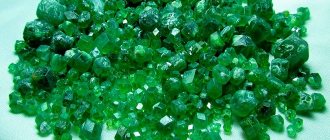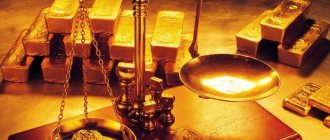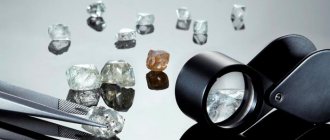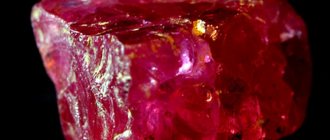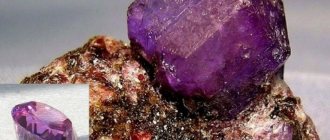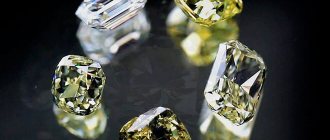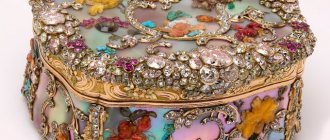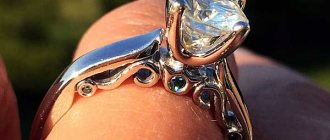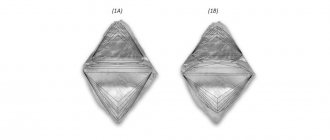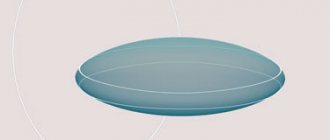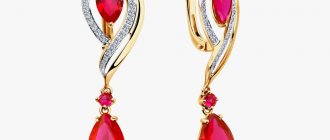June 17, 2021
Varieties of precious stones and their names are a topic for literally all times. No matter how enlightened the 21st century may be, the debate about what is considered the most valuable gems and what is only suitable for cheap crafts still does not subside. It is not for nothing that minerals are compared to stars - the glory of some burns for millennia, accompanying humanity, while others fly by like a comet with breaks for long oblivion, but they all personify the beauty of the natural depths.
We have prepared a lot of material for you, what kind of precious stones there are, how much the most expensive gems in the world cost, and how to distinguish natural minerals from skillful fakes.
What determines the cost of a stone?
Today, there are five criteria that directly affect the price of a crystal.
Weight
The most obvious point is that the heavier the stone, the larger it is, the more expensive it is. The main unit of measurement is the carat, equal to 0.2 grams. Next, the average market tariff is included in the calculation; here, each mineral has its own “critical” mass. For example, you will not find jewelry with a diamond even half a carat in a regular store, because its cost will be around 500 thousand rubles, but for a ruby this weight or even more is considered the norm.
Color
Jewelry making is a strict compliance with standards; it is not for nothing that everything associated with a noble profession is considered synonymous with precision. This approach also affected the shades of stones, where 14 colors were taken as standards, except for transparent, which is indicated separately:
- Green;
- Red;
- Yellow;
- Black;
- Pink;
- Orange;
- Grey;
- Blue;
- Blue;
- Violet;
- Brown;
- Black;
- White;
- Multicolor.
It should be understood that it is not only the color palette that determines the value. Maximum compliance with the standard is also important. When the shade of cut raw materials is too light or dark, its value decreases, which is good for the buyer, but not for the master jeweler.
Ennoblement
The vast majority of stones, except for transparent ones, end up on store shelves with “pumping” of color, that is, ennobled. This word refers to laboratory procedures, the purpose of which is to bring the blank of future inlay into conformity with its presentation. There are 5 common methods actively used by manufacturers:
- Heating is technologically simple, when pre-cut stones are placed in a special furnace, where they are heated to extreme temperatures. This allows you to even out the shade, make it more saturated or, conversely, mute it.
- Diffusion is an advanced heating method in which each workpiece is pre-coated with ions of a particular metal that serves as a color catalyst. After cooling, the transformation of the shade remains for many years or forever.
- Sputtering is a technology that gave birth to the famous mystic topaz, which has the effect of an iridescent kaleidoscope. It was invented in 1993 in the USA, when a special film of titanium composition was applied to the surface of the mineral.
- Irradiation – radiation allows you to change and “tweak” colors throughout the rainbow spectrum, the main thing is to correctly calculate the dose. The downside is the need to keep processed gems in sealed lead capsules for months.
- Glass filling - more precisely, a special type of crystal is used, which hides physical defects, voids and cracks without damage. According to Russian GOST, up to 50% of the volume is allowed; if more, the stone receives the status of composite.
As you might guess, crystals with minimal changes are valued more than others, but they are found extremely rarely in nature, and in the case of rubies or sapphires they are simply on the verge of fantasy. It is important for the buyer to remember that even an ennobled gem continues to remain precious, and minor interventions do not in any way affect its beauty.
Purity
The most controversial parameter, since many experts call the so-called inclusions in the structure of a mineral perhaps the main criterion of authenticity. Heterogeneity is inherent in any natural element, but jewelry precision requires the strictest classification, so there is a gradation of purity that divides stones as follows:
- Group 1 – the maximum possible shine and transparency, flaws in the structure are visible only under an electron microscope or a strong magnifying glass.
- Group 2 – there are subtle defects that can be seen with a household office magnifying glass.
- Group 3 – inclusions visible to the naked eye, slightly dimming transparency and optical effects.
- Group 4 – fairly large flaws, gloss significantly lower than the standard.
- Group 5 – the crystal structure is damaged, cracks and cavities are present, serious refining is required.
Depending on the manufacturer, a code is indicated on the jewelry tag, most often in the form of a decimal fraction. It should be read with the resulting number so that it is as close to the whole as possible. For example, 3/1 means exceptional quality, pure inlay, but 3/6 results in 0.5 - we have a low-grade insert, close to the fifth group.
Cut shape
It’s relatively simple here - automation of production bases has made life easier for many jewelers, however, intricate shapes still require painstaking manual labor. The following styles are considered popular among buyers, regardless of the category of stone:
- Circle;
- Square;
- Baguette;
- Cabochon;
- Oval;
- Heart;
- Marquis;
- Princess;
- Pear;
- A drop.
Of course, there are a dozen patented cuts - Antwerp rose, happy, magna and many others. Each of them reveals the iridescent brilliance of the gem in its own way, but no one has canceled the rule of labor costs - the more complex the composition, the more expensive the results.
Didn't find your stone in our catalog - order it
Our collection of colored stones is large, but it may not satisfy the needs of the most demanding customers. In this case, we offer the service of searching and selecting a custom-made gemstone. Our gemologists will search for the stone for you. Depending on the complexity of the order, selection may take from several days to several weeks, but rest assured, we will complete your order. To order, we are ready to select stones of top characteristics with certificates from the world's leading gemological laboratories. There is no point in listing everything, we will only note those stones that are often ordered rather than bought from stock: natural unheated Royal Blue or cornflower blue sapphires, unrefined rubies of Pigeon blood color (pigeon blood), Paraiba tourmalines of Brazilian origin, red Burmese spinel and much more etc.
Types of precious stones in jewelry. Top 5 minerals
To be fair, it should be said that according to Russian laws, only five stones have the right to be called precious, based on the main criteria. Another thing is that they are periodically joined by varieties of semi-precious gems, but more on them a little later.
Diamond (diamond)
The standard of natural purity and the most expensive stone in percentage terms. Jewelry with diamonds has been considered an elite segment of the entire jewelry market for several centuries - they are used to encrust romantic engagement rings, and pendants and pendants with shiny diamond scatterings are usually called a royal accessory. Needless to say, absolutely all manufacturers strive to create their own diamond catalogue.
Sapphire
Blue, like a warm, gentle sea - such epithets are most often heard about sapphires, which in structure are one of the varieties of natural corundum. The fact that 99% of retail stones are refined before further production does not in any way affect their physical properties. Moreover, very little of them are mined in Russia, which directly increases the price, which includes delivery from Asian countries and examination costs.
Ruby
This is the name of precious corundum of red-raspberry color, which in nature can be very pale, but after refining, like sapphire, it receives a new life. The romantic name of the most popular shade on the market - pigeon blood - has not caught on here, but every store has an extensive catalog of jewelry with rubies. The most expensive crystals are those containing rutile - it gives the starry effect so beloved by ladies.
Emerald
Beryl dioxide, a grass-green hue with an admixture of silicon and aluminum, better known as emerald, is a favorite of millions of women around the world. It is no coincidence that Victor Hugo gave the Spanish name of the mineral as a name to the beautiful Esmeralda - the enchanting, mysterious and attractive power of this stone needs no introduction. The cost is due to small proven reserves - 95% are mined in Latin America.
Alexandrite
The rarest of all stones mined in Russia is named in honor of Emperor Alexander II. Its calling card is the unique physical property of the “chameleon”, which changes the colors of the crystal in a wide range from green to lilac. To understand the value - in order to find 100 grams of alexandrite suitable for further jewelry work, 97.3 thousand tons of stone are processed annually.
The laws of the Russian Federation include certain types of sea pearls grown in natural conditions, as well as amber, as non-mineral precious stones. True, to get into the “elite club”, a solar nugget must be more than 1 kilogram of pure mass, and also contain samples of prehistoric fossilized fauna and flora.
Description
Amber is not a mineral; it does not form crystals in nature. It is a fossilized resin, a hardened resinous thick mass that comes out of cuts in coniferous trees. Covered with new layers, such resin forms an amazing stone, which has not lost its popularity for several centuries.
Raw amber is a stone that has not undergone any treatment. Its appearance remains in its original form - the one in which nature itself created it.
Main characteristics:
- shades: common - from light yellow to brown, less common are red, almost colorless, milky white, greenish;
- low hardness - 2.5 on the Mohs scale;
- transparency usually varies - from completely transparent, almost transparent to completely opaque;
- becomes fragile when aging;
- Excellent polishability;
- becomes electrified by friction;
- It ignites easily even from the flame of a match, while emitting a pleasant aroma.
Since the discovery of amber, stones that contain special inclusions have been especially valued. They are called inclusions. These are fossils of living organisms that have stuck to resin and then become covered with new layers of resin. The most common inclusions are representatives of insects, plants, and less often - vertebrates and mammals. Unprocessed amber with such content looks unusual and unique. Inside the sun stone you can find spiders, ants, flies, beetles, mosquitoes, bees, dragonflies, midges, but there are also plant inclusions - blades of grass, fluff, animal fur, moss, tree bark, plant stems.
Unprocessed amber, in which such inclusions are larger than 10 mm in size, is considered precious.
There are a lot of amber deposits: Ukraine, Russia, Myanmar, Sri Lanka, Indonesia, Dominican Republic, Mexico.
Top 10 most expensive stones in the world
It may sound ironic, but the most valuable minerals are never used in mass jewelry production; a simple buyer is unlikely to ever be able to see them on store shelves. The reason is banal - they are so rare in nature that literally every gem obtained is sent to natural science museums or private collections.
First place. Red Diamond
Price for 1 carat – from $1,000,000
The undisputed record holder is the carbon compound that forms a blood-red diamond crystal. In the entire history of mankind, only 30 nuggets have been found, 70% of which have a nominal weight of less than 1 carat. Each auction with such a lot is truly a world event, and the starting price tag of a million US dollars will seem like a mere trifle compared to the total amounts for which they are sold.
Second place. Taaffeit
Price 1 carat – $35,000
If the Austrian gemologist Richard Taaffe had not sent a piece of faceted spinel of a strange dark purple color that he found in Dublin in 1945 for examination, we would never have known about his name stone. This compound is unlike any known mineral, and its unique hue, coupled with its natural rarity, found exclusively in China, has made it one of the record holders for jewelry value - twice as expensive as a diamond.
Third place. Grandidierite
Price 1 carat – $20,000
The turquoise heart of Madagascar almost stopped beating when the last vein, discovered before the First World War, dried up in the sixties. This largely determined the high cost of blue stones with a unique pearlescent sheen inside. Today, on the southern tip of the African island, 2-3 nuggets are mined per year, each of which receives a certificate of authenticity for further cutting and inlay.
Fourth place. Serendibit
Price 1 carat – $18,000
The Serendib mineral, which received the Arabic name of the island of Sri Lanka, began to be mined back in 1902, but over the course of a century it was possible to find hardly more than a couple of dozen stones. At first glance, it is a coal-black crystal, but when bright sunlight hits it, a bright blue, greenish or yellow light “lights up” inside. For its “alien” texture, it earned a truly magical reputation and a market value that is 20% more expensive than a diamond.
Fifth place. Red beryl
Price for 1 carat – $10,000
The pride of Utah made several generations of prospectors multimillionaires until Bixbite, as the Americans call it, was discovered in southern New Mexico. Nowadays, the rarest shade of beryllium silicate is found much more often than 20 years ago, but its cost does not yet appear to decrease. The most valuable examples are deep purple stones; the blood red hue is more affordable, but still cannot be found outside the United States.
Sixth place. Musgravit
Price 1 carat – $6000
A relict mineral from Australia, whose homeland is the mountain range with the gloomy name Musgrave. According to the molecular formula, it is an oxide compound of magnesium with beryllium, which gives three natural colors - gray-transparent, olive green and lavender. It rightly tops the ratings of the rarest jewelry minerals - over its half-century history, only 15 pieces of jewelry inlaid with this stone have been officially registered.
Seventh place. Benitoite
Price 1 carat – $4000
California sapphire, as it is informally nicknamed by connoisseurs, is mined in the only deposit on the planet, located near San Benito County. The structure is barium silicate with strong inclusions of titanium, due to which a unique deep shade of blue is obtained. Another interesting property is the fluorescent effect, which is activated by direct exposure to ultraviolet light and lasts for at least several hours.
Eighth place. Poudretteite
Price 1 carat – $3000
Very little is known about the mineral, except that it received its name from the surname of the owner of the mining company, the only mines of which are located in Canada and Myanmar. This is an extremely fragile crystal, famous for its “glamorous” color palette - from pastel purple to bright pink, almost never found in nature. Since 2000, a little more than 30 nuggets suitable for further cutting and sale have been found.
Ninth place. Fire opal
Price 1 carat – $2500
Unlike regular semi-precious silica, its hyacinth-colored counterpart boasts exceptional transparency, which determines its high price. It is known for certain that the rings of Roman emperors were decorated with fire opals. The tradition passed on to monarchical Europe - Napoleon Bonaparte adored such stones and even gave his wife Josephine a faceted masterpiece worth 30 thousand Venetian ducats in gold.
Tenth place. Eremeevit
Price 1 carat – $2000
The first stone, named after the great Russian mineralogist Pavel Eremeev, was found in the Transbaikal mines at the end of the 19th century, but it received a detailed scientific description only 70 years later. This is a unique aluminum borate compound that has a delicate bluish tint that resembles freshly set ice. When heated, it can change color to green, but as soon as it cools down, it returns to its original appearance.
Types of semi-precious stones
According to generally accepted standards, they are grouped into so-called orders according to their current value among jewelers, natural rarity and unique physical properties. If we take the five unconditionally precious minerals as the first group, the list will continue:
- Second order - aquamarine, amethyst, zircon, topaz, beryl, opal.
- Third order - rauchtopaz, garnet, rock crystal, turquoise, tourmaline, peridot, citrine.
- Fourth order (precious stones) – jasper, malachite, onyx, obsidian, jade.
The main nuance that corrects domestic classifications is the prevalence of a particular mineral in a particular region. The most striking example here is Karelian shungite. We make entire tabletop sculptures 10 centimeters high from it, but in Latin American countries the exotic stone is sold at the price of an amethyst or even a garnet.
How to distinguish stones from fakes?
Each mineral, both precious and semi-precious, has its own set of fairly simple rules that are guaranteed to distinguish them from synthetic imitations:
- The main “tester” of diamonds is bright sunlight, which the diamond structure does not refract. Try to look through the insert at the sun, you will see only a tiny dot, or put a pebble on a piece of paper with text, the letters will become indistinguishable.
- You will have to look carefully at the emerald through a magnifying glass. Today, even large jewelry brands save on refining, so a cobweb of a veil almost always forms inside a green crystal - microcracks due to sudden overheating.
- Ruby, even after leveling the shade, should not be too bright - raspberry-red color is considered the standard. Deviation into dark tones indicates the presence of a large percentage of impurities, and excessive pallor indicates low quality corundum.
- Sapphires have recently become extremely difficult to distinguish from synthetic analogues, but there is one reliable way. Always pay close attention to the uniformity of color. In natural refined stone it is heterogeneous, but without sharp transitions.
- A pomegranate is checked, first of all, by its size - if the crystal is larger than a grain of everyone’s favorite fruit, most likely it is glued together from several parts. A neodymium magnet is also useful, as it slightly attracts the burgundy mineral.
- They have learned to counterfeit a black diamond with carborundum or cubic zirconia that perfectly imitates it. The light test for a cognac shade is useless, but a 20x magnifying glass will help you see the double edges characteristic of any “synthetics”.
- Pearls are tested in two ways. Not squeamish buyers can appreciate it “to the teeth”, because sea peas have a specific crunch due to microscopic burrs. Another method is a regular needle, which will not scratch natural mother-of-pearl.
- Aquamarine differs from cheap plastic in its unique optical effect - it slightly changes shade at different angles of refraction. A cat's eye is examined in a similar way - its vertical highlight is strictly even and symmetrical, without kinks.
- Rauchtopaz will give itself away with a star-shaped effect, just like an expensive ruby. It appears due to the special molecular structure where rutile is included. In addition, real smoky quartz is never the same - its shades vary.
- It will take a long time to check lapis lazuli at home - you need to put the jewelry in a glass of water at room temperature for several hours. If the gem was tinted for richness, the liquid will show this perfectly.
- Amethysts instantly reveal a fake under the light of an ultraviolet lamp - in this spectrum the stone should become completely colorless. When the shade becomes even darker than in the sun, we see a roughly colored piece of quartz glass.
- Citrines also very quickly confirm their authenticity, thanks to a temperature test - carefully warm it with the flame of a lighter and watch the color change. As soon as whitish or reddish spots appear, feel free to return the jewelry.
- Solar amber does not need to be set on fire - just vigorously rub the surface with a woolen cloth for a few seconds. Strong electrification is a good sign. In addition, when kept in warm hands for a long time, high-quality amber does not have stickiness.
The most counterfeited stone in the world, no matter how strange it may sound, is Egyptian turquoise, which is gradually becoming rare in its homeland due to centuries of uncontrolled mining. A real pebble is similar in structure to marble - rough, with obvious contrasting veins and specks. A polished glossy surface is found only in cheap composite jewelry, which is assembled from ground pressed residues.
Interesting facts about gemstones
Let's check if you know:
- The high price of a diamond is not only due to its natural rarity. Almost 80% of all mined crystals are simply unsuitable for jewelry. They are sent to industrial needs for the manufacture of drills, glass cutters and other tools.
- Colombia is the world leader in emerald mining. Explored reserves are estimated at record levels, approximately 20 tons of ore per 1 carat of raw material suitable for production. There are only three mining towns - Muzo, Chivor and Cosques.
- Saltwater pearls, contrary to popular belief, can grow in huge quantities inside a single shell. Thus, some varieties of Indian Ocean mussels contain from several dozen to hundreds of pearls of different diameters.
- Sapphires and rubies in Rus' were called the same - yakhont. The people's love for them was so great that the word yacht became synonymous with impeccable beauty.
- Topazes owe their name to the island of Topazios, which once belonged to the Egyptian queen Cleopatra. Ironically, chrysolites were mined there.
- Amethyst is called a stone of sobriety by adherents of mysticism. This came about due to an erroneous translation from Greek, where “metistos” means a drinking person.
- The only continent where there are no proven reserves of precious stones is Antarctica. However, according to international protocols, any mining is prohibited there.
Our country is the largest exporter of diamonds, occupying almost a third of the world market. Diamonds made from Russian raw materials enjoy the highest prestige among leading European jewelry houses. Belgium alone annually purchases stones worth over 1.3 billion euros, the second importer being the United Arab Emirates.
The most popular stone inserts in jewelry
Often, representatives of the fair sex, receiving jewelry as a gift, cannot understand what kind of red, blue or green stone it is. Of course, experts will say that the time has long passed when stones were identified only by color.
Now, in the age of technology and science, any consumer can contact special gemological laboratories, where they will have their stones examined and evaluated.
In this article we will not delve into the jungle of such a science as gemology (“gemma” means stone, “logy” means study, description). We will briefly describe the most common insertions. And we will distribute them by color.
RED
RUBY
Ruby is a transparent red variety of corundum. And only with the combination of these two qualities can a stone bear the proud name - ruby! The same mineral of a different color and transparent is a stone with a name of two words: the first indicates the color, the second, “sapphire,” means that this corundum is transparent. Examples: pink, colorless (leuko-) sapphire and only blue color can be called simply sapphire. Hardness on the specialized Mohs hardness scale (with a maximum of 10 points) is 9 points, i.e. Only diamond is harder. The ruby palette can vary from light red stones to rich red shades.
Ruby is one of the four most expensive jewelry stones. Star-shaped crystals with specific inclusions of rutile needles. Because of this, they have a visual effect called asterism - a star is visible on the surface: in the center there is a bright point, from which six shining rays radiate across the surface. Unique rubies are valued at higher prices than diamonds.
There are also rubies that stand out with a red-violet hue, which are called “pigeon blood”. Rubies of a deep red hue, with a faint purple tint, are of great value.
POMEGRANATE
Garnet is a mineral that basically has a deep red color and a “pure flame” hue and is highly hard. It is part of groups that have a strong variation in silicate color, which contain different cations. In appearance and color, the crystal resembles the grain of a pomegranate fruit, hence its name. But pomegranates are distinguished not only by their red color. This mineral is not very expensive, but in terms of the beauty of color and its depth it can compete with both ruby and emerald. By the way, fiery red pyrope was extremely popular in the last century, but when a huge batch of garnet entered the world market, it led to the undeserved relegation of the mineral to a precious stone of secondary importance.
RED CZ
Cubic zirconia is a stone that is of inorganic origin; it is characterized by such properties as hardness, strength, dispersion, and has high chemical and thermal resistance. Red cubic zirconia is an imitation of garnet.
BLUE
SAPPHIRE
Sapphire means “blue” in Greek. Interestingly, this stone, with its piercing blue color, is the closest relative of the red ruby. Sapphire owes its color to impurities of titanium, and sapphire is also corundum. Nature has endowed this mineral with a variety of shades: from soft blue to deep blue and even lilac. There are sapphires that have asterism effects. These crystals are called star crystals; when viewed under the right lighting, they reveal a sparkling, mesmerizing six-pointed star. Sapphire has a hardness of 9 on the Mohs scale.
Sapphire is one of the four most expensive stones in the world. The most valuable thing is the Kashmir sapphire, which has a cornflower blue color; what makes it stand out is that it retains its color in any light, even artificial light; this is considered a rarity for this crystal. The brighter and more intense the natural blue of a sapphire, the more expensive its cost.
TOPAZ London Blue
This stone is very popular in the foreign market, less often in the Russian market. Blue topazes come in different shades: from muted light sky to rich blue. London Blue is usually called a dark gray-blue topaz, sometimes called “steel” or “ink” blue, or colloquially you can find the name Topaz London. As with other stones, the more intense the color of topazes, the higher their value.
GREEN
EMERALD
Emerald is the name given to bright green beryl. Its green color is due to the presence of impurities of iron, chromium and vanadium. It has a hardness of 8 (Mohs). Emerald is very fragile and often chips and cracks reduce the quality of this stone. Because of this, the edges of this crystal are even engraved to make defects less visible. Emerald is the highest grade of jewelry crystal, and some of them are worth more than diamonds.
PRASIOLITE (green quartz)
Prasiolite is a green transparent quartz and is characterized by an exceptional bright green hue that is considered very rare.
AQUAMARINE
Aquamarine is a type of beryl mineral. Aquamarine shimmers in a range of incredibly beautiful shades from the blue airy sky color to the deep rich sea color. And indeed, traditionally, the color of this mineral can be compared with the color of aquamarine, and if you look at it from different directions, you can see how the color of aquamarine differs.
TRANSPARENT
DIAMOND
A diamond is a scientific name for a type of crystalline carbon. It has a Mohs hardness of 10, the hardest stone. As a result and thanks to its special internal structure, a process of strong splitting of light occurs within it, which provides an unsurpassed and unique game or, in other words, iridescence.
MOISSANITE
If these stones were natural, they would most likely outshine diamonds, but no reserves of mussanite were found, and what was lucky enough to be excavated is not suitable for jewelry. However, they have learned to artificially produce synthetic mussanites, which are silicon carbide. They are manufactured, or rather, they will even be “grown” at a temperature of 1400 ° C and at a pressure of 500 thousand bar. What's interesting and amazing is that there is a way to make perfect crystals of any size and configuration, even one square meter in area. These are unusually beautiful stones, even during the manufacturing process they can be given a wide variety of shades, there are so many advantages in it. But there is another most important thing - the cost, which is ten times less than the cost of diamonds.
FIANIT
Cubic zirconia is zirconium dioxide, that is, an artificial diamond that is grown in laboratory conditions.
